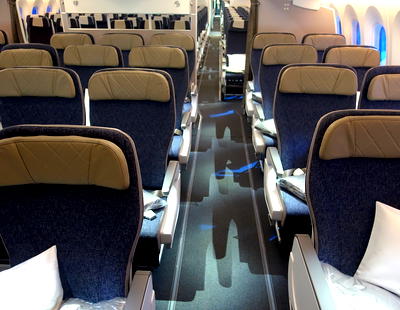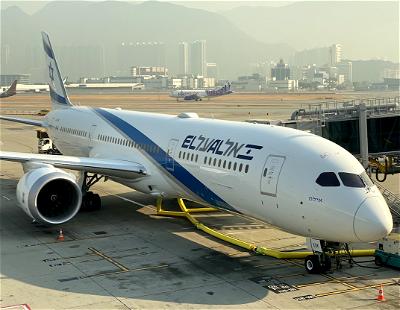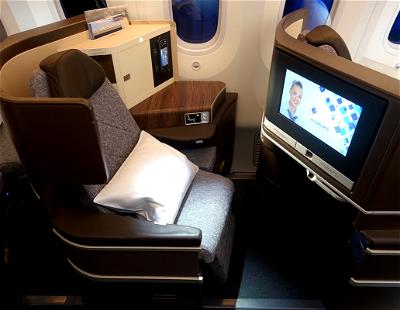EL AL is having a rough couple of weeks. Last week EL AL was in the news for their horrible handling of a flight that ended up diverting in order to observe Shabbat, and now they’re in the news because one of their 787s took off 80,000 pounds heavier than calculated.
This incident actually happened on a March 29 flight from Tel Aviv to Newark, operated by a 787. The reason it’s in the news now is because Israeli investigators have just completed their investigation of what happened.
During takeoff, the flight struggled to get airborne. The plane “rotated” right around its stall speed, and it took 13 seconds from the time the plane rotated until it reached an altitude of just 35 feet (that’s something that usually takes just a few seconds).
So, what was the cause of this incident? As it turns out, the pilots incorrectly programmed the onboard computer. Pilots will enter all the weights into their onboard computer (they know how much the plane weighs “dry,” they know how much fuel they have, they use average weights for passengers, etc.).
In this case, though, they entered a zero-fuel weight of 128 tons, rather than 168 tons, so they were off by 40 tons.
Based on all the data the pilots entered they were given their takeoff speed, which is why they decided to rotate at 154 knots, rather than the 175 knots that would have been required with the plane’s correct weight. This meant that the plane rotated more or less at its stall speed, and this also caused a tail-strike protection system to activate.
The pilots only realized their error when they passed through about 20,000 feet. That’s because the onboard computer recommended an altitude of 38,000 feet rather than the usual 34,000 feet. This is the point at which their instincts kicked in, as they realized there’s no way the plane could reach such a high altitude so early in the flight (this is why on a longhaul flight you’ll find that you gradually climb, because the plane’s optimum cruising altitude increases the more fuel you burn off).
The investigation concluded that:
- The pilots were rushed, since the inbound flight arrived late
- The 787 is still a new plane type for EL AL, so that may have contributed to this, as the pilots may not have had the same “instincts” they’d have if they had flown the plane for a long time
- The first officer didn’t correctly cross-check the data entered by the captain
- They were taking off in darkness, which makes it tougher to discern the plane’s weak takeoff performance
Bottom line
This is an interesting incident from EL AL. The airline is known for their excellent pilots, and of course it’s easy to sit here and say “how the heck didn’t they notice the 40 ton discrepancy?” But humans make mistakes, and it’s fortunate that this ended the way it did. Hopefully it doesn’t happen again.





This was totally my hat tip lol. Woohoo I got something on the blog
If these pilots knew anything about their airplane, they should have known a rotation speed of 154 knots was not feasible. These kind of speeds used to be pounded into pilots in training in the service. The real danger here is an early rotation so close to stall speed makes the engines work harder to gain the correct takeoff speed. Your chances of running out of runway before liftoff increase quite a bit.
Could someone more Davy please let me know if the safety of passengers in danger at any time due to this error?
We have seen this before: Emirates A340 in Melbourne, Qantas 737 in Sydney...
ZFW = weight of aircraft frame + passengers + cargo.
Major mistake which fortunately turned around for the better outcome ;)
@Brett: One issue with warnings like this is alert exhaustion. I’m accustomed to health care electronic medical records, which have all sorts of warning like that about large changes in patient weight, allergies, vitals outside of acceptable ranges, etc. When there are too many alerts, people get fatigue from the frequent alerts and ignore them. Doctors and nurses then select “OK” for all alert warnings that come up. I agree with you that this sounds...
@Brett: One issue with warnings like this is alert exhaustion. I’m accustomed to health care electronic medical records, which have all sorts of warning like that about large changes in patient weight, allergies, vitals outside of acceptable ranges, etc. When there are too many alerts, people get fatigue from the frequent alerts and ignore them. Doctors and nurses then select “OK” for all alert warnings that come up. I agree with you that this sounds like an important metric, but this is why automated alerts are not the only practical solution.
I imagine that, if you have experienced pilots flying 787s routinely, they would have done a double-take at the numbers they were entering and recognized that this is much lower than what they usually type in. But maybe not. No system is perfect; in this case, two pilots failed at entering the numbers correctly.
What I would do is add entries to the list of weights that create redundancy. Therefore, although entering the zero weight, weight of fuel, and weight with fuel would seem to be redundant, a computer could acknowledge that the numbers do not reconcile if entered incorrectly and force re-entry, or a human would be more likely to notice that a takeoff fuel weight of zero is impractical.
More bad news for LY: "A senior official of El Al Airlines was arrested on Monday along with three other suspects on suspicion of smuggling drugs into Israel, the Israel Police said on Monday."
The official, Rami Yogev, was manager of the Development and Resources Department at El Al and worked for the company for two decades. He is suspected of smuggling large amounts of cocaine to Israel aboard El Al planes
https://www.jpost.com/Israel-News/Senior-El-Al-official-arrested-for-allegedly-smuggling-drugs-572839
They're really...
More bad news for LY: "A senior official of El Al Airlines was arrested on Monday along with three other suspects on suspicion of smuggling drugs into Israel, the Israel Police said on Monday."
The official, Rami Yogev, was manager of the Development and Resources Department at El Al and worked for the company for two decades. He is suspected of smuggling large amounts of cocaine to Israel aboard El Al planes
https://www.jpost.com/Israel-News/Senior-El-Al-official-arrested-for-allegedly-smuggling-drugs-572839
They're really on a roll...
What I mean is that it should know possible and typical ranges. If you put in a number that's unusual software ought to proactively point it out. A weight 40k too low might result in a pop-up that says "are you sure this is correct? It implies no/few passengers on this flight"
Maybe it does already. Or maybe they just prefer that the copilot cross check, which apparently was a failure in this case.
@ Brett, no because the ZFW includes things like baggage, passengers, and cargo. It is not simply the weight of the plane without anything on it. I don't believe that the plane has the technology to essentially weight itself (though I could be wrong here).
But shouldn't the computer know the zfw of the 787? It seems like that weight might be possible with no passengers or cargo but ought to be flagged by software as atypical. Sounds like an enhancement request!
Ya to clear something up here, entering a Zero Fuel Weight (ZFW) has nothing to do with the amount of the fuel on the plane. ZFW is the weight of the plane less fuel, so this was not a case of the computer thinking it had zero fuel, but rather receiving an input of the weight less fuel much lower than it actually was. I would imagine the computer would not let you operate the plane if you entered a fuel amount as 0 (though this is just a guess).
Follow up on the Shabat incident - El Al decided to issue bonus tickets to European destinations for all passengers on board that flight (according to media outlets)
Read the original article and it states:
"Analysis of the preparations for the 29 March flight to Newark found that the captain had entered a zero-fuel weight of 128t, some 40t lower than the actual figure of 168t."
That does not read like they put in zero for the fuel, but rather that they actually entered an zfw of 128t instead of 168t, which would be a typing error and reads much more credible.
A...
Read the original article and it states:
"Analysis of the preparations for the 29 March flight to Newark found that the captain had entered a zero-fuel weight of 128t, some 40t lower than the actual figure of 168t."
That does not read like they put in zero for the fuel, but rather that they actually entered an zfw of 128t instead of 168t, which would be a typing error and reads much more credible.
A 787-9 has a max ZFW of 181t, so the computer would have accepted 128t, assuming very low pax number.
Pilots entering values for the amount of fuel, and software not catching blatantly obvious errors? How on earth is this actually the process involved? This is 2018, right?
Wow scary. Much like the recent temperature incident.
So they forgot to cross check? Let me guess, did they forget the checklist too?!? LOLZOR
I didn't know that planes generally climb higher as they burn fuel!
I agree. Something’s missing here. Computer should have recognized that “0” is not a valid fuel entry for pushback much less an overseas flight.
doesn't the FQIS system automatically detect the fuel quantity for this 'task'? something is off here
Maybe you should write about Lion Air as well. Investigators found the plane was not 'airworthy'
....." or more accurately, they put zero as the fuel amount,"
Like, this highly computarized machine does not realize it cannot run with zero fuel?
Would understand had they missed a digit, but with fuel valued at zero, the computer should realize this cannot be correct if the engines are running....
There's a "your mother" joke in there somewhere.